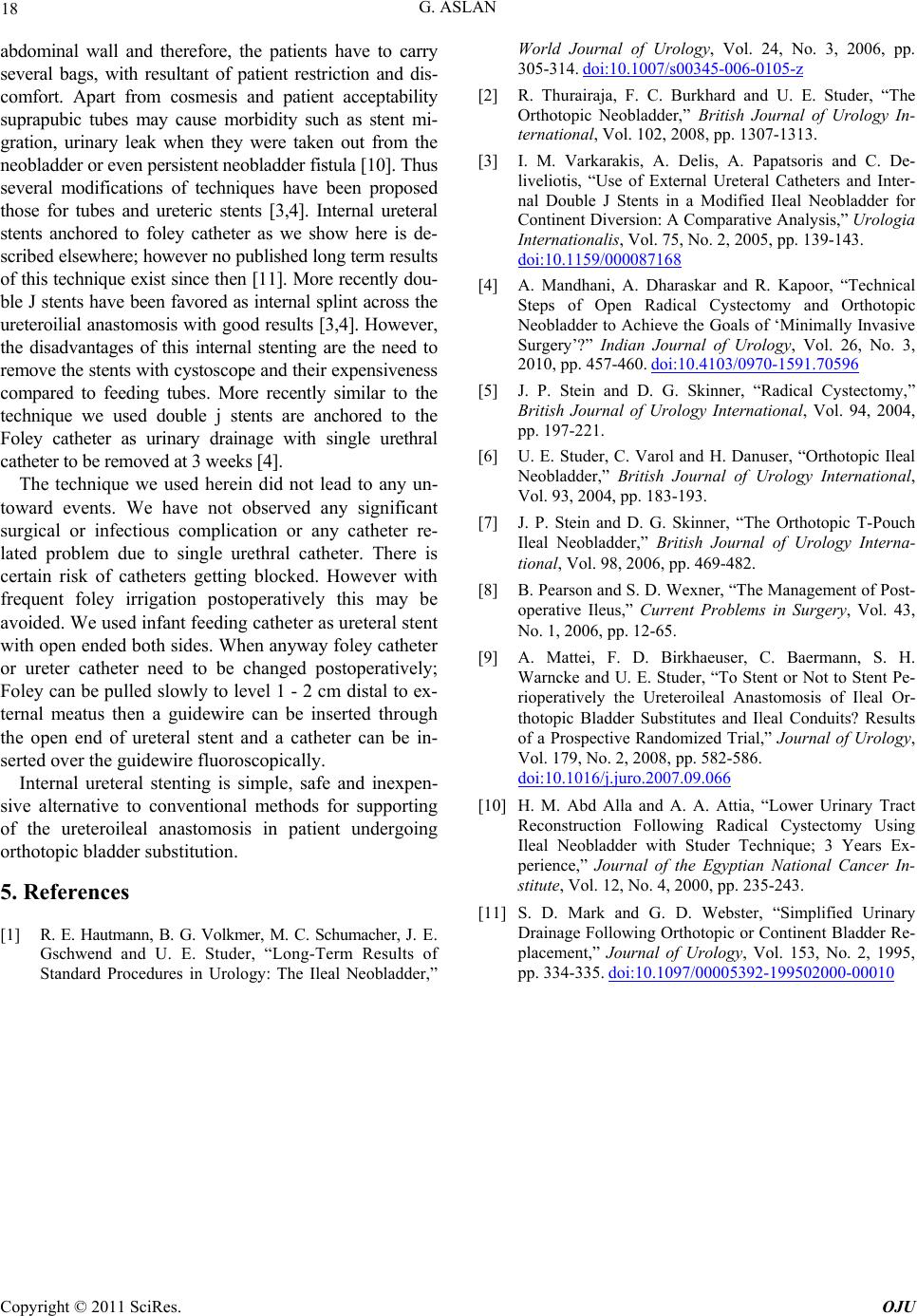
18 G. ASLAN
abdominal wall and therefore, the patients have to carry
several bags, with resultant of patient restriction and dis-
comfort. Apart from cosmesis and patient acceptability
suprapubic tubes may cause morbidity such as stent mi-
gration, urinary leak when they were taken out from the
neobladder or even persiste nt neobladder fistula [10] . Thus
several modifications of techniques have been proposed
those for tubes and ureteric stents [3,4]. Internal ureteral
stents anchored to foley catheter as we show here is de-
scribed elsewhere; however no published long term results
of this technique exist since then [11]. More recently dou-
ble J stents have been favored as internal splint acro ss the
ureteroilial anastomosis with good results [3,4]. However,
the disadvantages of this internal stenting are the need to
remove the stents with cystoscope and their expensiveness
compared to feeding tubes. More recently similar to the
technique we used double j stents are anchored to the
Foley catheter as urinary drainage with single urethral
catheter to be removed at 3 weeks [4].
The technique we used herein did not lead to any un-
toward events. We have not observed any significant
surgical or infectious complication or any catheter re-
lated problem due to single urethral catheter. There is
certain risk of catheters getting blocked. However with
frequent foley irrigation postoperatively this may be
avoided. We used infant feeding catheter as ureteral stent
with open en ded both sides. When anyway foley catheter
or ureter catheter need to be changed postoperatively;
Foley can be pulled slowly to level 1 - 2 cm distal to ex-
ternal meatus then a guidewire can be inserted through
the open end of ureteral stent and a catheter can be in-
serted over the gu idewire fluorosco pi ca ll y.
Internal ureteral stenting is simple, safe and inexpen-
sive alternative to conventional methods for supporting
of the ureteroileal anastomosis in patient undergoing
orthotopic bladder substitution.
5. References
[1] R. E. Hautmann, B. G. Volkmer, M. C. Schumacher, J. E.
Gschwend and U. E. Studer, “Long-Term Results of
Standard Procedures in Urology: The Ileal Neobladder,”
World Journal of Urology, Vol. 24, No. 3, 2006, pp.
305-314. doi:10.1007/s00345-006-0105-z
[2] R. Thurairaja, F. C. Burkhard and U. E. Studer, “The
Orthotopic Neobladder,” British Journal of Urology In-
ternational, Vol. 102, 2008, pp. 1307-1313.
[3] I. M. Varkarakis, A. Delis, A. Papatsoris and C. De-
liveliotis, “Use of External Ureteral Catheters and Inter-
nal Double J Stents in a Modified Ileal Neobladder for
Continent Diversion: A Comparative Analysis,” Urologia
Internationalis, Vol. 75, No. 2, 2005, pp. 139-143.
doi:10.1159/000087168
[4] A. Mandhani, A. Dharaskar and R. Kapoor, “Technical
Steps of Open Radical Cystectomy and Orthotopic
Neobladder to Achieve the Goals of ‘Minimally Invasive
Surgery’?” Indian Journal of Urology, Vol. 26, No. 3,
2010, pp. 457-460. doi:10.4103/0970-1591.70596
[5] J. P. Stein and D. G. Skinner, “Radical Cystectomy,”
British Journal of Urology International, Vol. 94, 2004,
pp. 197-221.
[6] U. E. Studer, C. Varol and H. Danuser, “Orthotopic Ileal
Neobladder,” British Journal of Urology International,
Vol. 93, 2004, pp. 183-193.
[7] J. P. Stein and D. G. Skinner, “The Orthotopic T-Pouch
Ileal Neobladder,” British Journal of Urology Interna-
tional, Vol. 98, 2006, pp. 469-482.
[8] B. Pearson and S. D. Wexner, “The Management of Post-
operative Ileus,” Current Problems in Surgery, Vol. 43,
No. 1, 2006, pp. 12-65.
[9] A. Mattei, F. D. Birkhaeuser, C. Baermann, S. H.
Warncke and U. E. Studer, “To Stent or Not to Stent Pe-
rioperatively the Ureteroileal Anastomosis of Ileal Or-
thotopic Bladder Substitutes and Ileal Conduits? Results
of a Prospective Randomized Trial,” Journal of Urology,
Vol. 179, No. 2, 2008, pp. 582-586.
doi:10.1016/j.juro.2007.09.066
[10] H. M. Abd Alla and A. A. Attia, “Lower Urinary Tract
Reconstruction Following Radical Cystectomy Using
Ileal Neobladder with Studer Technique; 3 Years Ex-
perience,” Journal of the Egyptian National Cancer In-
stitute, Vol. 12, No. 4, 2000, pp. 235-243.
[11] S. D. Mark and G. D. Webster, “Simplified Urinary
Drainage Following Orthotopic or Continent Bladder Re-
placement,” Journal of Urology, Vol. 153, No. 2, 1995,
pp. 334-335. doi:10.1097/00005392-199502000-00010
Copyright © 2011 SciRes. OJU